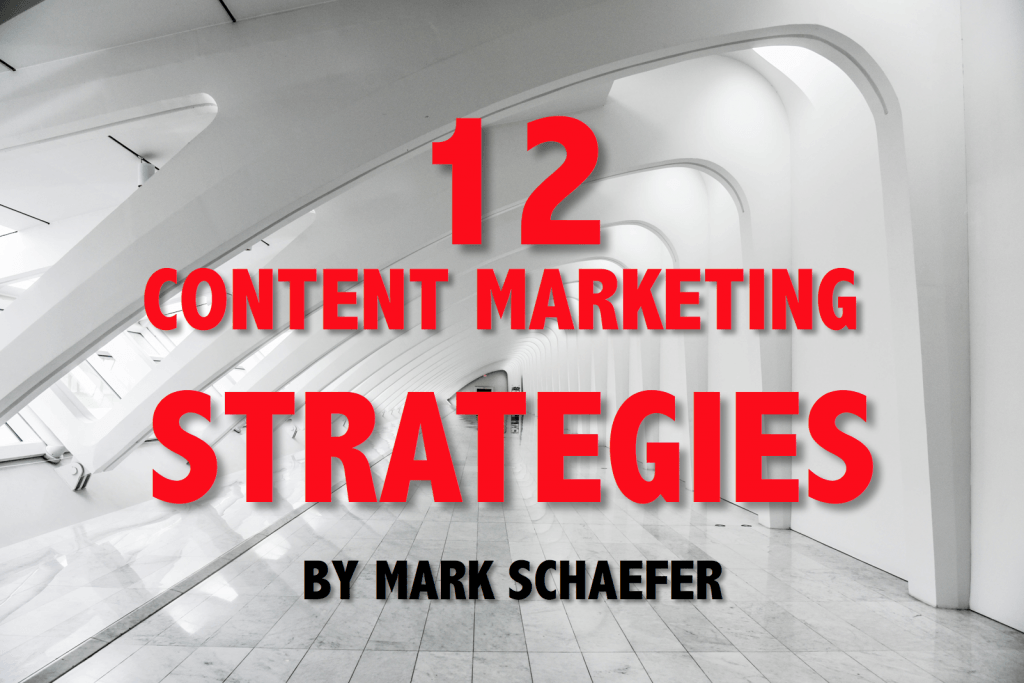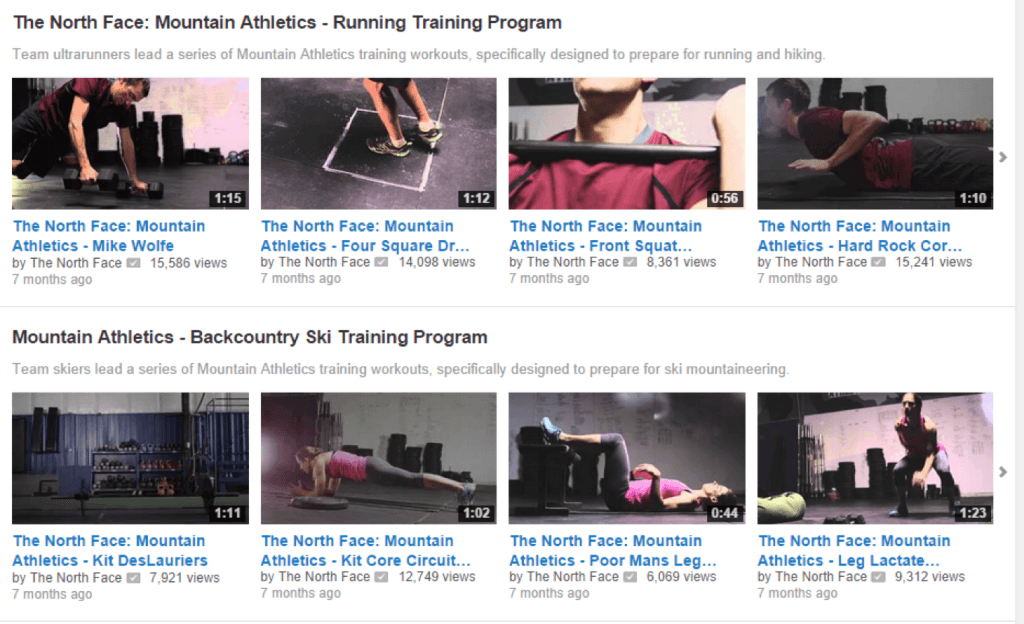
By Mark Schaefer
The other day I saw a very fine post entitled “Writing for SEO” by my brilliant friend Andy Crestodina.
But when I saw the headline of this post, I thought, “well, you don’t ALWAYS have to write for SEO. In fact, sometimes writing for SEO is exactly the wrong thing to do!”
I know this might sound confusing … don’t we always want to appease Google and attract organic traffic? Well, it depends.
I decided to create a very simple guide to clarify and simplify your content marketing strategies based on your business goals and the type of content that can best achieve those goals. Ready?
First, let’s identify four common content business goals and the three basic content types. Then, I’ll show you a clever way to put it all together.
FOUR CONTENT BUSINESS GOALS
Writing to achieve SEO results is a popular business goal, but it’s not the only one. Here are four different content business goals:
1. SEO — Creating content that attracts search engine traffic depends on aiming at targeted keywords, creating headlines and content that support those keywords, and generally delivering a piece that conforms to Google’s search rules. An example of this would be a nutrition company creating how-to blog posts that answer commonly-asked questions submitted to Google. But conforming to Google’s rules can also be limiting …
2. Customer service — A second content strategy would be one aimed at serving current customers. Content in this category might cut customer service costs by answering product-related questions, for example. This strategy teaches customers how to use your products, how to get the most out of their investments, and perhaps even encourage them to consume more by using your products in new ways.
3. Authority — If you want to stand out by establishing yourself as a thought leader, then writing only in Google-speak can hold you back. Establishing yourself as an authoritative leader in your category means creating content that is compelling and original, not something based on common keywords.
This has been my strategy. I write posts that go to new places, that push new ideas. The type of person who would hire me would be attracted to me because of the way I think, not necessarily because my posts do well in search results.
4. Awareness/Launch — Content can be critical to attract attention to a new product or service. Early in the life of a business, it’s difficult to win an SEO battle, establish authority, or connect to customers. You need to be known, and fast. The challenge is that normally a start-up doesn’t have the audience, or the resources to build awareness very quickly. So using content to create rapid awareness presents a unique challenge.
THREE CONTENT TYPES
Now let’s look at three broad content types. A few years ago, YouTube published a research paper proposing that companies who established the strongest brands on social media did so by publishing three different types of content.
1. Hygiene Content — This is the content that answers consumer questions. It is a staple of the “inbound” marketing model. An example would be an insurance company brainstorming every question a potential customer could have about their product and then answering those questions through blog posts or a video series.
Here’s an excellent example of hygiene content from North Face. The company provides extensive resources to help answer customer questions about preparing for outdoor activities:

The problem with hygiene content is that once somebody finds an answer (usually through search), they’ll probably leave your site. That’s why you also need …
2. Hub Content — This content is represented by the evergreen stories that might make a consumer want to click another and then another. You are drawing them into the site by providing content that is addictive, educational, and entertaining. An example might be adventure videos on the GoPro YouTube site, beautiful recipes on a niche cooking site, a podcast that explores political issues in-depth, or maybe even the wide-ranging marketing topics represented on the {grow} blog.
3. Hero Content — This content is built to go viral. It’s bold, epic and unique. Increasingly, big brands like BMW, Nike, Chipotle, Heineken, and Red Bull are creating this type of content to rise above the noise. Typically these are Hollywood-style mini-movies meant to create massive social media shares and views.
Although this hero content might be “big budget,” it may still be a fraction of what it would cost to get similar attention through traditional advertising buys. Here’s an example of hero content from H&M (directed by the famed director Wes Anderson, with more than 10 million views!):
If you can’t see this video within the post, click here to view on YouTube: Example of Hero Content.
Putting it all together
So, we have examples of four content business goals and three high-level types of content to serve those goals. ln this chart, we can see how these combinations work together to create 12 possible content strategy blocks. Green would symbolize “go,” yellow would indicate there is some connection, and a red box would mean there is a disconnect between that content type and business goal.

I’ll summarize how you might use this helpful system.
Looking across the first horizontal line, you can see that if your goal is to drive organic search results through Search Engine Optimization, the focus would be on investing in hygiene content that answers questions and uses keywords that are highly relevant to your products and services. Hub content might also be useful to this goal, but you would probably never invest in hero content as a top priority.
If your goal is to serve and educate customers, useful hygiene content would be a key content investment, as well as interesting hub content pieces that keep customers on your site and build stronger relationships. Hero content? Probably not.
Establishing thought leadership requires breaking away from the pack. You don’t want to “optimize” anything. You need to create revolutionary content that makes people think in new ways and share your ideas. The emphasis would be on evergreen “hub” content and possibly even hero content.
An example of using hero content to establish authority would be Eric Qualman’s breakthrough “Social Media Revolution” video. He simply assembled social media facts and compiled them into an upbeat video in 2011. This one video turned into an annual series that propelled Eric into a book deal and a lucrative career as a motivational speaker. Here is the latest edition of that video:
If you can’t see the video within the post you can view it on YouTube here: Example of Thought Leadership Content.
Finally there is the awareness/launch strategy line. A business in this situation probably doesn’t have the time and resources to build the domain authority needed to dominate common key words and search. A new business needs to make a splash with some unusual hub or hero content.
One of my favorite examples is the “First Kiss video” created by fashion designer Melissa Coker. To break out in this crowded space she needed to create vast awareness on a small budget. With a few friends, she created a video for under $1,500 that was risky and provocative. And it worked. The little video garnered more than 123 million views and increased the annual sales of her Wren clothing line by 1,400 percent.
If you can’t see the video above you can view it on YouTube here: Example of Hero Content.
Another key strategy for companies in the awareness/launch phase is to use influencers to help ignite your content beyond the company’s normal audience, which is exactly how the inexpensive Wren video went viral. But that’s a topic for another day.
Content marketing strategies simplified
Creating content marketing strategies can seem overwhelming. But this system of viewing your starting point as the intersection of goals and content type should at least point you in the right direction. Once you’re clear on your business goal and the type of content you need to prioritize, the real fun begins!
You still need to make big decisions like:
- Content form (written, audio, visual, video?)
- Publishing schedule
- Resources and budget
- Distribution and promotion
I also want to emphasize that there is no content strategy template that fits every business. Even what I have provided here is simply a guideline. There are always exceptions!
I would love to learn of your views of this system for content marketing strategies in the comment section.
 Mark Schaefer is the chief blogger for this site, executive director of Schaefer Marketing Solutions, and the author of several best-selling digital marketing books. He is an acclaimed keynote speaker, college educator, and business consultant. The Marketing Companion podcast is among the top business podcasts in the world. Contact Mark to have him speak to your company event or conference soon.
Mark Schaefer is the chief blogger for this site, executive director of Schaefer Marketing Solutions, and the author of several best-selling digital marketing books. He is an acclaimed keynote speaker, college educator, and business consultant. The Marketing Companion podcast is among the top business podcasts in the world. Contact Mark to have him speak to your company event or conference soon.
Illustration courtesy Unsplash.com
The post An indispensable guide to 12 possible content marketing strategies appeared first on Schaefer Marketing Solutions: We Help Businesses {grow}.
from {grow} http://feeds.feedblitz.com/~/467033648/0/markgrow~An-indispensable-guide-to-possible-content-marketing-strategies/
No comments:
Post a Comment